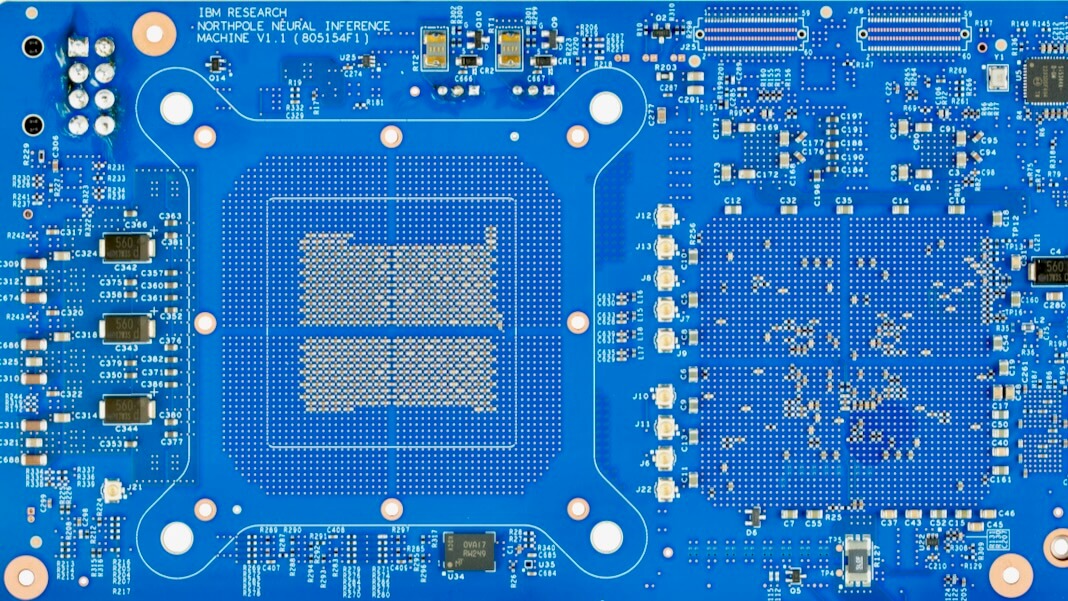
The mind is an exceptionally highly effective computing machine. Scientists have lengthy tried to recreate its internal workings in mechanical minds.
A crew from IBM might have cracked the code with NorthPole, a completely digital chip that mimics the mind’s construction and effectivity. When pitted in opposition to state-of-the-art graphics processing items (GPUs)—the chips mostly used to run AI applications—IBM’s brain-like chip triumphed in a number of customary exams, whereas utilizing as much as 96 % much less power.
IBM isn’t any stranger to brain-inspired chips. From TrueNorth to SpiNNaker, they’ve spent a decade tapping into the mind’s structure to raised run AI algorithms.
Challenge to venture, the objective has been the identical: How can we construct sooner, extra power environment friendly chips that enable smaller units—like our telephones or computer systems in self-driving automobiles—to run AI on the “edge.” Edge computing can monitor and reply to issues in real-time without having to ship requests to distant server farms within the cloud. Like switching from dial-up modems to fiber-optic web, these chips may additionally velocity up massive AI fashions with minimal power prices.
ALSO SEE: IBM announces first release of watsonx Granite model
The issue? The mind is analog. Conventional pc chips, in distinction, use digital processing—0s and 1s. In case you’ve ever tried to transform an previous VHS tape right into a digital file, you’ll comprehend it’s not an easy course of. Thus far, most chips that mimic the mind use analog computing. Sadly, these methods are noisy and errors can simply slip via.
With NorthPole, IBM went fully digital. Tightly packing 22 billion transistors onto 256 cores, the chip takes its cues from the mind by inserting computing and reminiscence modules subsequent to one another. Confronted with a activity, every core takes on part of an issue. Nonetheless, like nerve fibers within the mind, long-range connections hyperlink modules, to allow them to alternate data too.
This sharing is an “innovation,” said Drs. Subramanian Iyer and Vwani Roychowdhury on the College of California, Los Angeles (UCLA), who weren’t concerned within the examine.
The chip is very related in gentle of increasingly costly, power-hungry AI models. As a result of NorthPole is totally digital, it additionally dovetails with present manufacturing processes—the packaging of transistors and wired connections—doubtlessly making it simpler to provide at scale.
The chip represents “neural inference on the frontier of power, area and time,” the authors wrote of their paper, printed in Science.
Thoughts Versus Machine
From DALL-E to ChatGTP, generative AI has taken the world by storm with its shockingly human-like text-based responses and pictures.
However to check writer Dr. Dharmendra S. Modha, generative AI is on an unsustainable path. The software program is educated on billions of examples—usually scraped from the online—to generate responses. Each creating the algorithms and working them requires large quantities of computing energy, leading to excessive prices, processing delays, and a big carbon footprint.
These common AI fashions are loosely impressed by the mind’s internal workings. However they don’t mesh properly with our present computer systems. The mind processes and shops reminiscences in the identical location. Computer systems, in distinction, divide reminiscence and processing into separate blocks. This setup shuttles information backwards and forwards for every computation, and site visitors can stack up, inflicting bottlenecks, delays, and wasted power.
It’s a “information motion disaster,” wrote the crew. We want “dramatically extra computationally-efficient strategies.”
One concept is to construct analog computing chips just like how the mind capabilities. Fairly than processing information utilizing a system of discrete 0s and 1s—like on-or-off gentle switches—these chips perform extra like gentle dimmers. As a result of every computing “node” can seize a number of states, one of these computing is quicker and extra power environment friendly.
Sadly, analog chips additionally undergo from errors and noise. Much like adjusting a swap with a light-weight dimmer, even a slight mistake can alter the output. Though versatile and power environment friendly, the chips are tough to work with when processing massive AI fashions.
A Match Made in Heaven
What if we mixed the pliability of neurons with the reliability of digital processors?
That’s the driving idea for NorthPole. The result’s a stamp-sized chip that may beat the perfect GPUs in a number of customary exams.
The crew’s first step was to distribute information processing throughout a number of cores, whereas preserving reminiscence and computing modules inside every core bodily shut.
Earlier analog chips, like IBM’s TrueNorth, used a particular materials to mix computation and reminiscence in a single location. As an alternative of going analog with non-standard supplies, the NorthPole chip locations customary reminiscence and processing elements subsequent to one another.
The remainder of NorthPole’s design borrows from the mind’s bigger group.
The chip has a distributed array of cores just like the cortex, the outermost layer of the mind liable for sensing, reasoning, and decision-making. Every a part of the cortex processes several types of data, nevertheless it additionally shares computations and broadcasts outcomes all through the area.
Impressed by these communication channels, the crew constructed two networks on the chip to democratize reminiscence. Like neurons within the cortex, every core can entry computations inside itself, but additionally has entry to a worldwide reminiscence. This setup removes hierarchy in information processing, permitting all cores to sort out an issue concurrently whereas additionally sharing their outcomes—thereby eliminating a typical bottleneck in computation.
The crew additionally developed software program that cleverly delegates an issue in each area and time to every core—ensuring no computing assets go to waste or collide with one another.
The software program “exploits the complete capabilities of the [chip’s] structure,” they defined within the paper, whereas serving to combine “present functions and workflows” into the chip.
In comparison with TrueNorth, IBM’s earlier brain-inspired analog chip, NorthPole can help AI fashions which can be 640 occasions bigger, involving 3,000 occasions extra computations. All that with simply 4 occasions the variety of transistors.
A Digital Mind Processor
The crew subsequent pitted NorthPole in opposition to a number of GPU chips in a collection of efficiency exams.
NorthPole was 25 occasions extra environment friendly when challenged with the identical drawback. The chip additionally processed information at lighting-fast speeds in comparison with GPUs on two tough AI benchmark exams.
Primarily based on preliminary exams, NorthPole is already usable for real-time facial recognition or deciphering language. In concept, its quick response time may additionally information self-driving automobiles in split-second selections.
Pc chips are at a crossroads. Some specialists consider that Moore’s legislation—which posits that the variety of transistors on a chip doubles each two years—is at dying’s door. Though nonetheless of their infancy, different computing buildings, comparable to brain-like {hardware} and quantum computing, are gaining steam.
However NorthPole reveals semiconductor expertise nonetheless has a lot to offer. At present, there are 37 million transistors per sq. millimeter on the chip. However primarily based on projections, the setup may simply broaden to 2 billion, permitting bigger algorithms to run on a single chip.
“Structure trumps Moore’s legislation,” wrote the crew.
They consider innovation in chip design, like NorthPole, may present near-term options within the improvement of more and more highly effective however resource-hungry AI.
Picture Credit score: IBM
